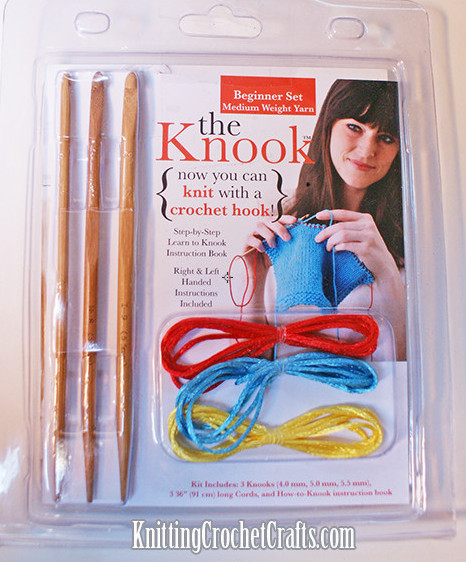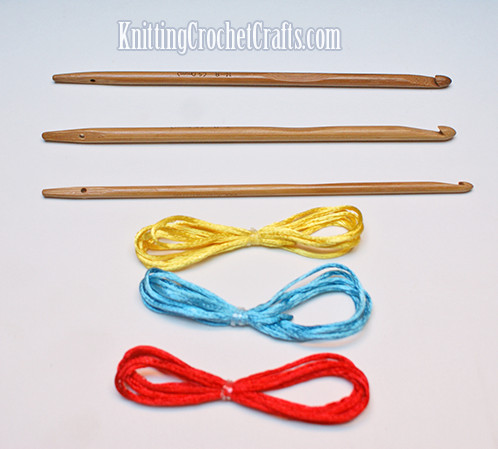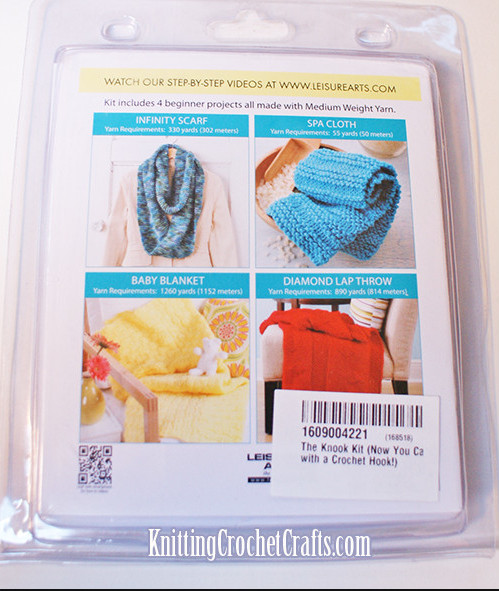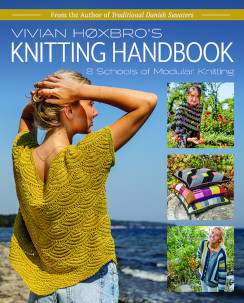
What’s “The Knook?” and What’s “Knooking?”
The “Knook” looks substantially similar to a crochet hook, but it has some important differentiating characteristics. One critical differentiator is the Knook’s small hole at one end of the hook. You thread a cord through this hole as a necessary and integral part of the knooking process. Leisure Arts manufactures this needlework tool.

”Knooking” is the term crafters use to refer to the process of creating knitted fabric using the Knook tool instead of other alternatives such as sets of knitting needles, a knitting loom, or a knitting machine.
What’s Included in the Knook Beginner Set for Medium Weight Yarn?
The Knook Beginner Set includes 3 Knook tools — sizes G – 6 (4.0 mm,) H -8 (5.0 mm,) and I – 9 (5.5 mm.) There are also 3 silky cords and a small instruction booklet that also has four beginner-friendly Knooking patterns.

Price I Paid for the Knook Beginner Set: I purchased a Knook Beginner Set for $9.95.
The Knook Instruction and Pattern Booklet
A small 32 page instruction booklet comes with the Knook Beginner Set. The booklet includes:
- Instructions for Knooking; it includes instructions, with pictures, for both right-handed and left-handed people.
- Infinity scarf / infinity cowl pattern. This is one pattern you could make two different ways; you just change the finishing a bit if you want a cowl instead of a traditional long scarf. The scarf is worked in garter stitch.
- A washcloth pattern. They call it a “spa cloth.”
- A baby blanket pattern. This is made in a lovely textured basketweave stitch.
- Diamond lap throw pattern. This throw features textured diamond motifs.
The book includes many color photographs which are clear and helpful. They illustrate the technique well.
The Knooking Technique
To prep the Knook, you’re supposed to put one of the cords through the little hole at the end of the hook. The first time I tried Knooking, I had a hard time doing this; the cord just didn’t want to go through the little hole. Yikes. It took me several attempts, but I finally got it through.
Later, after having a bit more experience with the Knook, I can better appreciate that the cord needs to fit snugly into the hole, so once it’s set up, the tight fit is beneficial.
Next, you work a series of crochet chain stitches; this process is exactly the same as the process for chaining with an ordinary crochet hook. However, that’s where the similarities to crochet end.
The next step is to pick up stitches while holding the Knook with the hook portion upside down. Next, you transfer the picked-up stitches onto the cord and turn the work over. Then you work the stitches, transferring each stitch onto the Knook as you go. The process has similarities to crochet and similarities to knitting, but it is distinct enough from both techniques to be its own unique category of crafting.
That said, the resulting fabric, structurally, is indistinguishable from weft knitted fabric. It is virtually identical. The “Knooked” samples I initially made have the look, the stretch, the texture, the drape and the feel of hand knitted fabric. This is significant, because the other crochet techniques I’m aware of that attempt to mimic knitting – including Tunisian knit stitch and shallow single crochet stitch — successfully capture the look of knitting but not the stretch, drape, texture or feel of it.
My Experiences With Knooking
I’m both a crocheter and a knitter, although these days I don’t do much hand knitting.
Since I already know how to knit with two knitting needles, I found this technique to be a little awkward in comparison to knitting. (And since I also machine knit, it’s definitely awkward compared to that.)
However, when I originally learned how to hand knit, it took me a long time and a lot of struggling. For me, learning how to Knook was easy in comparison.
The Knook has its downsides. One of them is that there’s a cord in your way every time you’re trying to make a stitch. I’m still new to this technique, and there’s a learning curve. I am hopeful that the technique will get easier with practice. Maybe, with practice, the cord won’t be bothersome.
For those who are already knitting successfully, I don’t think this tool is a must-have item.
However, for anyone who is interested in combining the two techniques — knitting and crochet — in the same project, the Knook could be a convenient tool. It is handy to be able to switch between Knooking and traditional crochet to create hybrid projects without having to switch back and forth between needles and hooks.
I think the Knook will appeal most to people who have tried to learn how to knit but have given up in frustration. For that group, I think it’s definitely worth considering this set.
I think the Knook Beginner Set is a good value for the money. I am satisfied with the quality of the tools, and with the instructions I received. I’m happy to recommend this product to crafters who are not already comfortable with knitting using the previously existing methods.
Where to Buy the Knook Beginner Set for Medium Weight Yarn
The Knook Beginner Set Is Available for Sale at Amazon.com.
More Knitting, Crochet and Needlework Resources:

- Crochet That Looks Like Knitting: Tunisian Knit Stitch Tutorial
- Tunisian Knit Stitch Dishcloth — Free Crochet Pattern
- Yarn for Crochet and Knitting
- Crochet Books
- Knitting Books
/
By Amy Solovay
About the Author: Amy Solovay is a real person; she is NOT a robot and does not use artificial intelligence (AI) to create patterns, illustrations or articles for this website. She is a real, live, human content creator and educator who holds a bachelor’s degree with a studio art minor; she has also earned a separate degree in textile design. Amy learned to crochet as a small child, and she still enjoys crocheting all these years later. Beyond that, she enjoys introducing other crafters to the best new craft supplies, and she also loves helping crafters learn new techniques for making the most of the craft supplies they buy.
As an educator, Amy Solovay used to teach in-person college courses in trend forecasting, marketing and surface design at California Design College in Los Angeles.
Nowadays, Amy uses online platforms to teach digital courses to craft pattern designers, content creators and influencers all over the world.
Thanks for visiting!
This page was last updated on 10-4-2024.